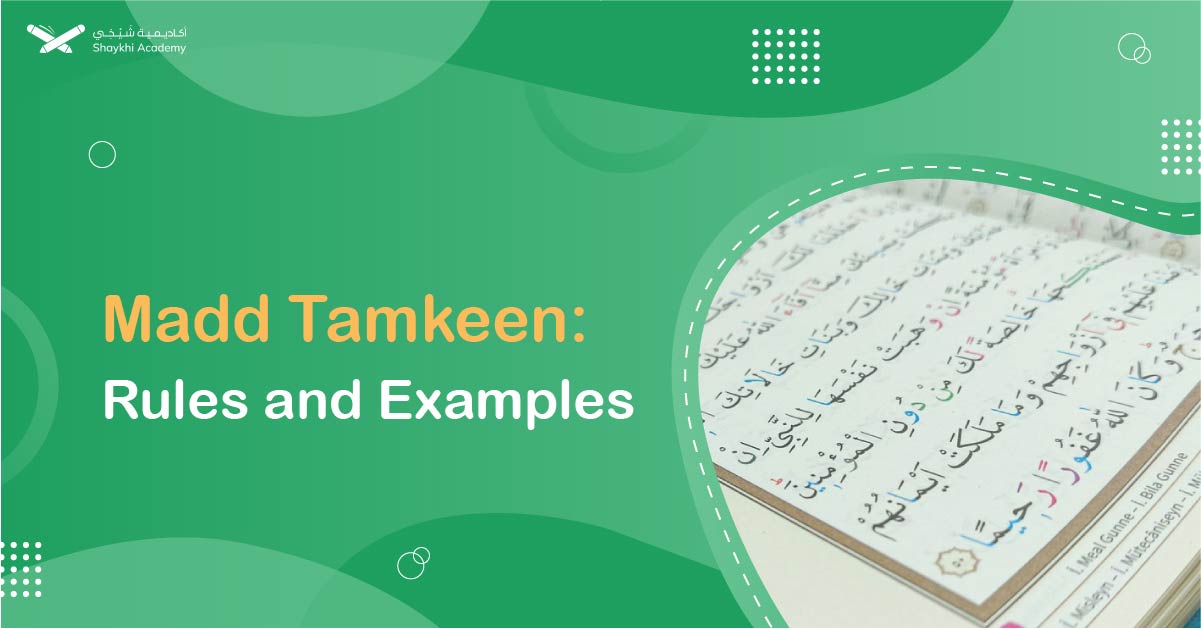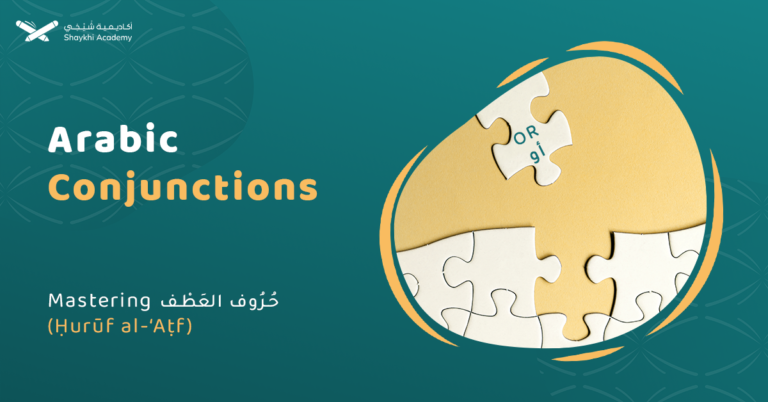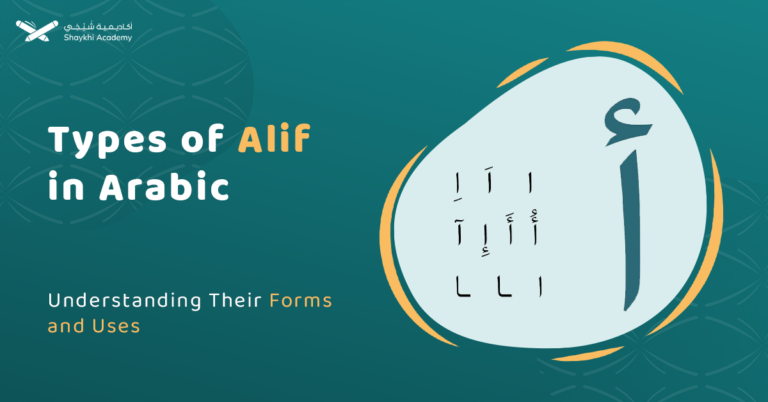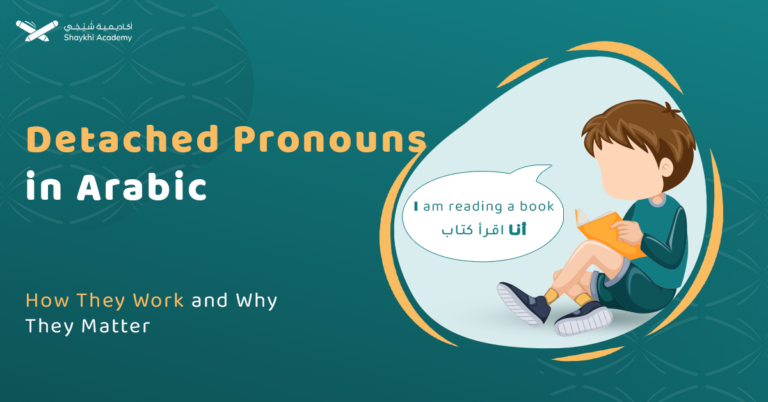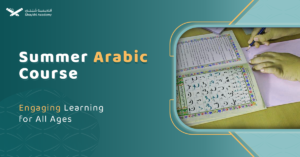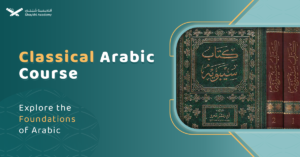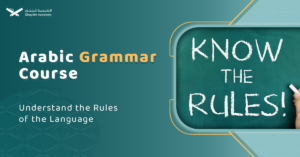Madd Tamkeen in Quranic recitation ensures precise pronunciation of elongated letters like waw and yaa, maintaining clarity by avoiding their merger and emphasizing distinct pronunciation with a two-count duration. Mastering Madd Tamkeen is crucial for accurately reciting Quranic verses, enhancing both fluency and understanding of the sacred text.
Introduction to Madd:
As we know, there are several types of Madd we should master when we read the Quran. One of these types of Madd is Madd Tamkeen, which we will discuss in this article.
Before we explain Madd Tamkeen, it is important to remember that the letters of Madd are:
- Consonant alef (alef sakkenah) (ا), which is pronounced as alef and is preceded by a letter with fatha.
- Consonant yaa (yaa sakkenah) (ي), which is pronounced as yaa and is preceded by a letter with kasra.
- Consonant waw (waw sakkenah) (و), which is pronounced as waw and is preceded by a letter with dammah.
By understanding these foundational elements, we can better realize the concept of Madd Tamkeen and its application in Quranic recitation.
Definition of Madd Tamkeen
Madd Tamkeen is a type of natural Madd (Madd Tabi’y) where the letter of Madd is elongated for a duration of two counts. The word “Tamkeen” means empowering or enabling, so Madd Tamkeen involves lengthening, increasing, and achieving the Madd with the waw and the Madd with the yaa.
Madd Tamkeen occurs when:
- Waw as a letter of Madd is followed or preceded by another waw with harakat (fatha, kasrah, or dammah).
- Yaa as a letter of Madd is followed or preceded by another yaa with harakat (fatha, kasrah, or dammah).
This only happens in the middle of words.
Examples of Madd Tamkeen
Here are examples of both cases:
Example 1 of Madd Tamkeen
(فَمَن تَعَجَّلَ فِی يَوْمَيْنِ فَلا إثْمَ عَلَيْهِ)
In the word (في), yaa is a Madd letter because the letter before it has a kasrah. It is followed by yaa with a fatha in the word (يَوْمَيْنِ). Therefore, the first yaa in the word (في) should be elongated by two counts before moving to the yaa that follows it in the word (يَوْمَيْنِ), as defined in Madd Tamkeen.
Example 2 of Madd Tamkeen
(يَا أَيُّهَا الَّذِينَ آمَنُوا اصْبِرُوا وَصَابِرُوا)
Explanation: In the word (اصْبِرُوا), waw is a Madd letter because the letter before it has a dammah. It is followed by waw with a fatha in the word (وَ). Therefore, the first waw in the word (اصْبِرُوا) should be elongated by two counts before moving to the waw that follows it in the word (وَصَابِرُوا), as defined in Madd Tamkeen.
It is also important to note that the alef in these words is present due to an Arabic grammar rule.
What is the importance of Madd Tamkeen in reciting the Quran?
Madd Tamkeen in Quranic recitation ensures clear pronunciation and distinct elongation of letters like waw and yaa, maintaining the accuracy and integrity of the Quran’s recital.
1. Preserving Clarity of Letters:
Madd Tamkeen helps to clearly distinguish between letters, ensuring that the waw as a Madd letter followed by another waw with harakat, and the yaa as a Madd letter followed by another yaa with harakat, are not merged (idgham) but are pronounced separately and distinctly.
2. Avoiding Omission of Madd Letters:
It is essential not to omit the waw as a Madd letter or the yaa as a Madd letter while reading the Quran. These letters must be pronounced clearly and with the proper elongation to ensure the accuracy of the recitation.
Types of Madd Tamkeen
There are two main types of Madd Tamkeen, each of which is further divided into subtypes that we will discuss and explain:
1- Madd Tamkeen with Waw:
This occurs when a waw as a Madd letter is followed or preceded by another waw with harakat (fatha, kasrah, or dammah).It can be found either within a single word or between two words.
2- Madd Tamkeen with Yaa:
This occurs when a yaa as a Madd letter is followed or preceded by another yaa with harakat (fatha, kasrah, or dammah).
By understanding these types and their subdivisions, we can apply the rules of Madd Tamkeen accurately in Quranic recitation.
Rules of Madd Tamkeen:
Madd Tamkeen rules involve prolonging certain letters in Quranic recitation. It applies to the second of two waws in a word, like in (يَلْوُونَ), and the first waw in the continuous recitation of two words, like in (آمَنُوا وَعَمِلُوا); similarly, it applies to the second of two yaas in a word, such as in (حُيِّيتُمْ).
Here are the details:
1- Madd Tamkeen with Waw:
A. When two waws come in one word:
In the word (يَلْوُونَ), the second waw is a Madd letter because the first waw before it has a dammah. During recitation, you must apply Madd Tamkeen to the second waw with a two-count duration, avoiding idgham (merging) of the two waws.
B. When two waws come in two words:
In the ayah (آمَنُوا وَعَمِلُوا), the waw in (آمَنُوا) is a Madd letter because the letter before it has a dammah, and the letter after it (وَ) is a waw with a fatha. During continuous recitation, you must apply Madd Tamkeen to the first waw. If you stop recitation at the word (آمَنُوا), it will be a natural Madd with a two-count duration.
2. Madd Tamkeen with Yaa:
A. When two yaas come in one word:
In the word(حُيِّيتُمْ)the second yaa is a Madd letter as the letter yaa before it has shadda, so during recitation, either during continuous or at stop you must apply Madd Tamkeen to the second yaa with a two-count duration, avoiding idgham (merging) of the two yaas.
B. When two yaas come in two words:
We already explain this type of Maad Tamkeen in the beginning of the article in the first example of ayah((فَمَن تَعَجَّلَ فِی يَوْمَيْنِ فَلا إثْمَ عَلَيْهِ)
By understanding these types and their subdivisions, we can apply the rules of Madd Tamkeen accurately in Quranic recitation, ensuring clarity and proper pronunciation.
How to learn Madd Tamkeen:
Learning Madd Tamkeen in Quranic recitation involves several steps to ensure accurate application:
1- Understanding the rules of Madd Tamkeen:
This involves grasping its types, subtypes, and recognizing their distinctions. This understanding helps in reciting accurately, avoiding common mistakes like merging letters (Idgham).
2- Practicing Pronunciation:
By recognizing examples of Madd Tamkeen in the Quran, practicing it with an expert, such as a Quran teacher at Shikhy Academy where there are professional teachers who can help you achieve mastery of your reciting.
3- Consistency:
Regularly practice your recitation to maintain proficiency in applying Madd Tamkeen and other Tajweed rules effectively.
4- Seek guidance:
We encourage you to apply the previous step with a professional guide who can teach you, correct your mistakes in recitation, teach you the rules of Tajweed, and give you honest feedback to improve your recitation. You can find such a professional guide at Shikhy Academy, where you can easily contact us for further information.
Unlock the Path to Quranic Mastery with Shaykhi Academy!
Are you seeking the finest Quranic education right from the comfort of your home? Look no further! Shaykhi Academy stands out as a premier online Quran learning platform, dedicated to providing exemplary education to both children and adults.
Why Choose Shaykhi Academy?
- Connect with highly qualified native tutors.
- Flexible scheduling to suit your busy lifestyle.
- Affordable classes tailored for all levels.
- Accessible from anywhere around the globe.
Discover Our Range of Courses:
- Arabic Noorani Qaida: Lay a solid foundation for Quranic studies.
- Online Quran Classes for Kids: Engaging lessons for lifelong learning.
- Tajweed Rules for Kids: Learn to recite with confidence.
- Quran Hifz for Kids: Step-by-step guidance to memorize the Quran.
- Quran for Adults: Introduce yourself to Quran reading and Tajweed rules.
- Online Arabic Courses: Master the language of the Quran.
- Islamic Studies: A wide range of topics related to Islam, including theology, law, Quranic studies, Hadith.
Don’t Miss Out on Your Chance to Excel!
Whether you’re a beginner or seeking advanced knowledge, Shaykhi Academy can guide you! Book your free trial now and make Ramadan 2024 your Quranic turning point!

Conclusion:
Madd Tamkeen is essential for precise Quranic recitation, focusing on elongating letters like waw and yaa without merging them, ensuring clarity and accuracy in pronunciation. Whether encountered within a single word, as in (يَلْوُونَ), or between words, as seen in (آمَنُوا وَعَمِلُوا), Madd Tamkeen dictates that these letters must be pronounced distinctly with a two-count duration. Mastering Madd Tamkeen not only upholds the integrity of Quranic verses but also enhances fluency in conveying their meaning, making it a fundamental skill for anyone learning to recite the Quran with proper Tajweed.
